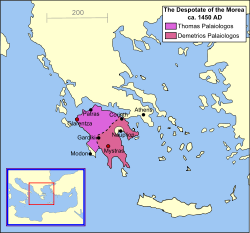Despotate of the Morea
Despotate of Morea Δεσποτάτο του Μυστρά | |||||||||
|---|---|---|---|---|---|---|---|---|---|
| 1308–1460 | |||||||||
 The Despotate of Morea in 1450, showing Mystras. | |||||||||
| Capital | Mystras | ||||||||
| Common languages | Greek | ||||||||
| Religion | Eastern Orthodox Church | ||||||||
| Government | Principality | ||||||||
| Despot | |||||||||
• 1308 – 1316 | Michael | ||||||||
• 1449 – 1460 | Thomas Palaiologos | ||||||||
| Historical era | Late Medieval | ||||||||
• Established | 1308 | ||||||||
• Disestablished | 1460 | ||||||||
| |||||||||
The Despotate of Morea (Greek: Δεσποτάτο του Μυστρά) was a province of the Byzantine Empire which existed between the mid-14th and mid-15th centuries. Its territory varied in size during its 100 years of existence but eventually grew to take in almost all the southern Greek Peloponnese peninsula, which at this time was called the Morea. It was usually ruled by the current Byzantine emperor's heir, who was given the title of despot or despoinis (in this context it should not be confused with despotism). Its capital was the fortified city of Mystras, near ancient Sparta, which became an important centre of Byzantine culture and power.
The despotate was carved out of territory seized from the Frankish Principality of Achaea. This itself had been carved out of former Byzantine territory following the Fourth Crusade (1204). In 1259, the Principality's ruler Guillaume II de Villehardouin lost the Battle of Pelagonia against the Byzantine Emperor Michael VIII Palaeologus. Guillaume was forced to ransom himself by giving up most of the eastern part of Morea and his newly built strongholds. The surrendered territory became the nucleus of the Despotate of Morea.
A later Byzantine emperor, John VI Cantacuzenus, reorganized the territory in the mid-14th century to establish it as an appanage for his son Manuel Cantacuzenus. The rival Palaeologus dynasty seized the Morea after Manuel's death in 1380, with Theodore I Palaeologus becoming the new despot of Morea in 1383. Theodore ruled it until 1407, consolidating Byzantine rule and coming to terms with his more powerful neighbours – particularly the expansionist Ottoman Empire, whose suzerainty he recognised. He also sought to reinvigorate the local economy by inviting Albanians to settle in the territory.
As Latin power on the Peloponnese waned during the 15th century, the Despotate of Morea expanded to incorporate the entire peninsula. However, in 1446 the Ottoman Sultan Murad II destroyed the Byzantine defences on the Isthmus of Corinth. His attack opened the peninsula to invasion, though Murad died before he could exploit this. His successor Mehmed II "the Conqueror" captured the Byzantine capital Constantinople in 1453 and seven years later overran the Despotate of Morea, destroying the last European fragment of the Byzantine Empire.
Byzantine despots of Morea at Mystras

(William R. Shepherd, Historical Atlas, 1911).
- Michael (1308-1316)
- Andronikos Palaiologos (1316-1322)
- Manuel Kantakouzenos (1348-?)
- Michael Asan ?
- Andrew Asan (?-1354)
- Manuel Kantakouzenos (restored) (1354-1380)
- Matthew Kantakouzenos (1380-1383)
- Demetrius I Kantakouzenos(1383)
- Theodore I Palaiologos (1383-1407)
- Theodore II Palaiologos (1407-1443)
- Constantine XI Palaiologos (1428-1449)
